Tasty Toasted Breads From Around The World
Today, I am taking my taste buds on a trip with a look at tasty toasted breads from around the world. Grab your boarding pass, fasten your apron strings, and get ready to explore how people in different countries create tempting treats by simply toasting bread!
Who knew that something as simple as toasting bread could become a canvas for culinary creativity in so many corners of the planet? From the sweetness of French Toast in Paris to the zesty flavors of Italian Bruschetta in Rome, toasted bread has woven its way into the hearts and kitchens of cultures near and far.
Let’s start this globe-trotting toasted adventure!
French Toast (France)
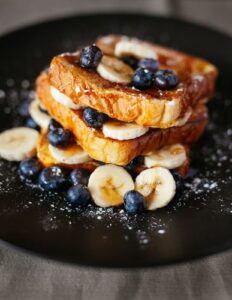
Picture this – a sunny morning in a quaint Parisian café, the aroma of freshly brewed coffee wafting through the air, and a plate of golden-brown, French toast placed before you. It is a breakfast fit for a dream! In France French Toast is called “Pain Perdu”, which means “Lost Bread”, a great name for a dish that gives a second chance to day-old bread.
Legend has it that this beloved breakfast treat was born out of necessity. Resourceful French cooks, who never let food go to waste, devised a way to revive stale bread . They soaked it in a mixture of eggs and milk, then fried it to golden perfection.
Creating the perfect French toast starts with selecting the right bread. While brioche and challah are popular choices for their rich, buttery textures, you can use any bread you have on hand. The key is to let it sit in a mixture of beaten eggs, milk (or cream), sugar, and a hint of vanilla or cinnamon. This custard bath not only infuses the bread with flavor but also gives it a sumptuous, custardy interior when cooked.
Once your bread is thoroughly soaked, it is time to heat up the skillet. Drop in a pat of butter or oil. Gently place each slice of soaked bread into the hot pan, and listen for the satisfying sizzle as it begins to cook. Cook each side until it’s beautifully golden brown, creating a crispy exterior that contrasts perfectly with the creamy interior.
Make Your Own French Toast
One of the joys of French toast is its versatility when it comes to toppings. Traditional options include a dusting of powdered sugar and a drizzle of maple syrup. You can also use fresh berries, sliced bananas, a dollop of yogurt, or a sprinkling of chopped nuts. For a decadent twist, add a scoop of ice cream or a dollop of Nutella – this is a favorite with my grandchildren! For a savory option, incorporate cheese and herbs. Bon appétit!
If you want to go one step further and make a decadent French Toast Casserole – here is a fabulous recipe that I love.
Arepas (Venezuela and Colombia)
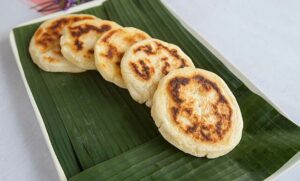
Walking through a vibrant street market in Caracas or joining a family gathering in Bogotá, the alluring aroma of grilling arepas fills the air. These delicious golden-brown, cornmeal creations are other tasty toasted breads from around the world. They are a staple of Venezuelan and Colombian cuisine and are a symbol of culture and tradition.
These round flatbreads represent the heart and soul of Venezuela and Colombia. They are are made from pre-cooked cornmeal, water, and a pinch of salt. This creates a dough that is shaped into discs and cooked to perfection on griddles or grills.
The history of arepas stems back to the indigenous peoples in the region who were crafting these mouthwatering creations long before the arrival of European settlers.
Creating the perfect arepa starts with selecting the right type of cornmeal, which can vary in coarseness. Mix the dough until it is just right – not too dry and not too wet. Then pat each round of dough into a disc, and then it is time to use the grill. Listen for the sizzle as they turn golden brown and acquire a slightly crispy exterior, while the interior remains soft and doughy.
Now, you can choose an array of fillings to stuff inside. From shredded beef and chicken to black beans, cheese, avocado, and even scrambled eggs, the possibilities are endless.
While arepas are often enjoyed for breakfast, they are suitable for any time of day. Whether served hot off the grill at a bustling street vendor’s cart or prepared with care in a family kitchen, arepas are a versatile choice. They are an integral part of family traditions and special moments. Buen provecho!
Geroosterd Brood (Netherlands)
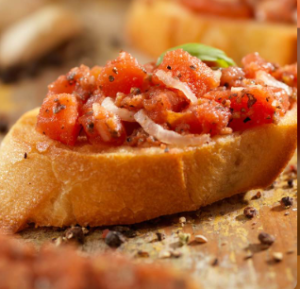
Let’s look at some other unusual tasty toasted breads from around the world. In the heart of the Netherlands, the art of toasting bread, known as “Geroosterd Brood,” holds a special place in the hearts and homes of the Dutch people. It is a ritual that’s much more than mere breakfast – it is a celebration of simplicity and flavor.
Geroosterd Brood, or toasted bread, was born out of a commitment to sustainability. In a culture that values minimizing food waste, this tradition provides a delicious solution for bread that might otherwise go to waste.
The process of making Geroosterd Brood is surprisingly simple. It begins with slices of yesterday’s bread, typically of the dense, rustic variety. These slices are carefully placed in a toaster, a pan, or under the broiler. As the slices of bread meet the heat source, the smell of toasted bread wafts through the kitchen, inviting all nearby to gather around. Each side of the bread is toasted until it reaches a perfect balance: crispy on the outside, but still soft and chewy inside.
Enjoy Geroosterd Brood in a variety of ways, with toppings that reflect both tradition and personal taste. For a classic touch, a thick layer of Dutch butter is often spread generously on the warm toast, followed by a sprinkle of “hagelslag,” Dutch chocolate sprinkles, or “gestampte muisjes,” a sweet aniseed topping.
While Geroosterd Brood is often enjoyed for breakfast or as an afternoon snack, it can be a delightful accompaniment to any meal. Whether served with a bowl of hearty Dutch pea soup (Erwtensoep) on a chilly winter’s day or as part of a festive brunch spread, Geroosterd Brood adds a touch of comfort to any occasion. Smakelijk eten!
Here is a recipe for gerooste brood that I love making.
Pita Bread (Middle East)
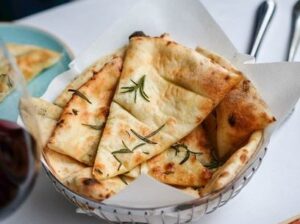
In the bustling souks (marketplaces) in the heart of the Middle East, the aromas of spices and sizzling meats fill the air. Amidst this culinary tapestry, there is a sizzling symphony of toasted pita bread. A timeless tradition that transcends borders and takes your taste buds on a journey through the flavors of the Middle East.
Pita bread, also known as “Arabic bread” or “pocket bread,” is an iconic symbol of Middle Eastern cuisine. Its history stretches back centuries, and its versatility has made it a cherished companion to countless dishes.
Creating the perfect pita bread is a craft that has been honed over generations. The dough is simple, made from flour, water, yeast, and a pinch of salt. After the dough is mixed and allowed to rise, it is divided into small, circular portions and rolled out into thin discs. Then place the delicate rounds of dough in a blazing hot oven or on a hot griddle. As the thin discs heat up, they puff up dramatically, forming a pocket in the center while the edges turn golden brown and slightly crispy.
What makes toasted pita bread truly special is its versatility. You can tear off a piece of warm pita and use it as a scoop for creamy hummus or smoky baba ghanoush. Alternatively, stuff it with grilled meats, fresh vegetables, and tahini sauce to create the beloved shawarma or falafel sandwich. Sahtein!
Bruschetta (Italy)
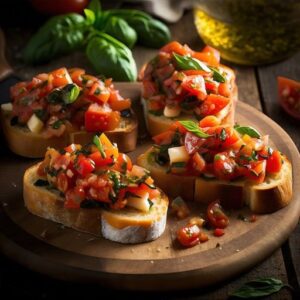
In a sun-drenched vineyard in Tuscany or a cozy trattoria in Rome, the air is filled with the scent of ripe tomatoes, fresh basil, and the warm embrace of toasted bread. This sensory sensation is none other than bruschetta, a classic Italian dish that is not just an appetizer. It is a celebration of the simple, honest flavors of Italy.
The story of bruschetta is a tale of rustic ingenuity. In the heart of Italy, where food is a celebration of life itself, farmers would toast slices of day-old bread over an open flame. This simple act transformed the bread’s flavor and texture, creating the foundation of what we now know as bruschetta.
The key to crafting the perfect bruschetta lies in the quality of the ingredients. Start with a hearty, rustic Italian bread, such as ciabatta or baguette. Slice it thickly, brush each side with olive oil, and toast it until golden brown. This toasting process infuses the bread with a rich, smoky flavor and a delightful crunch.
Toppings bring the bruschetta to life! Fresh, ripe tomatoes, garlic, basil, and a generous drizzle of extra-virgin olive oil top a classic bruschetta. The contrast of the warm, crunchy bread against the juicy tomatoes and fragrant basil is a revelation of taste and texture.
One of the beauties of bruschetta is its versatility. Italians embrace the seasons, so the toppings can change with the harvest. During summer, you might find variations with sweet, sun-ripened peaches or creamy burrata cheese. In the fall, roasted butternut squash or sautéed wild mushrooms take center stage. Buon appetito!
Melba Toast (Australia)
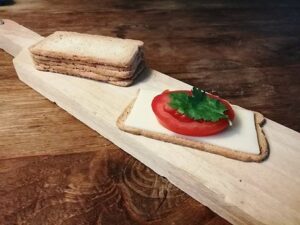

In the heart of Australia where the sun-kissed land stretches far and wide, there is a culinary treasure known as Melba Toast. And, it is much more than a crisp, slender slice of bread – it is a symbol of elegance and refinement in Australian cuisine.
Melba Toast is a creation that bears the name of the legendary Australian opera singer, Dame Nellie Melba. In the late 19th century, renowned French chef Auguste Escoffier was inspired to craft a thin, crisp toast in her honor. He aimed to create a culinary masterpiece as delicate and flawless as the diva’s voice. The result was Melba Toast, a testament to artistry in both music and cuisine.
Creating the perfect Melba Toast requires a meticulous touch. It begins with thin slices of white bread, carefully trimmed of their crusts to create uniformly delicate, rectangular slices. These slices are then toasted to a light golden hue, preserving their tender interior while achieving a satisfying crunch.
Melba Toast’s elegance lies in its simplicity and can be topped with sweet and savory toppings. For a refined appetizer, you might find it adorned with delicate smoked salmon, cream cheese, and a sprig of fresh dill. How about a dollop of rich, velvety pâté de foie gras? For a sweet treat, try a classic homemade peach or apricot jam. No worries mate!
Roti (India)
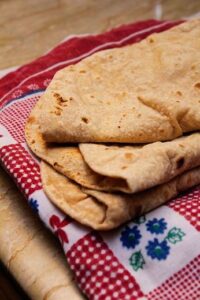
In a bustling Indian kitchen, where the warm, enticing aroma of fresh bread infuses the air, you will always find Roti. A fundamental, versatile, and beloved flatbread that embodies the very essence of Indian cuisine.
Roti’s history is as rich and diverse as the nation it hails from. It’s a bread that has nourished generations of Indians, providing sustenance and comfort. Its roots stretch back centuries, where it was traditionally cooked on an open flame, giving it a distinctive taste and texture.
Creating the perfect Roti is a craft that has been passed down through generations. The dough is simple, made from whole wheat flour, water, and a pinch of salt. Each round of dough is meticulously rolled out into a thin, circular shape, then cooked on a hot griddle or open flame. The Roti puffs up, creating layers that are tender on the inside and slightly crispy on the outside.
Roti is exceptionally versatile and is a staple that accompanies nearly every Indian meal. Use roti to scoop up rich curries, scoop up vibrant chutneys, and wrap around succulent kebabs. In essence, Roti is the perfect partner to the flavors of India. In the morning, serve Roti with butter and jam, or as part of a hearty breakfast. During the day, it’s a perfect snack, stuffed with savory fillings. In the evening, it takes center stage as an accompaniment to curries, daals, and a myriad of flavorful dishes. Enjoy!
The Wrap
If you prefer a plain slice of toasted white bread, or are in a hurry to make a quick meal, take a look at my suggestions for great toast toppings. They will add a great touch of chef quality to normal bread!
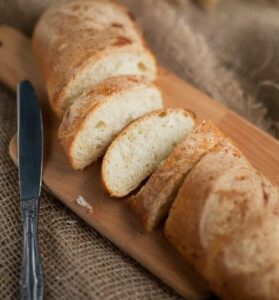
Bread should never be boring! Transform your day old bread into a delicious treat. By experimenting with my ideas above, you can travel the world in your own home and try out tastes from many cultures. These ideas are easy to make and will delight the family and friends. Cheers to toasted breads, the warm, crunchy treat that connects us all through the joy of food!

Hello There!
Hi! My name is Madlyn and I’m a modern tech-savvy Grandma with a passion for all-things-appliances.
If it has an On-Off switch, I want it! I have a job, a home, a husband, kids, grand kids, and pets – the whole nine yards. And, I have kitchen appliances …
My Appliance Journey
Over the years, my hubby and I have spent a fortune on appliances ranging from baby bottle warmers to large fancy fridges for a house full of growing teens.
Some were value for money and lasted for years, while others packed up in less than a month.
Over the years I have gained vast experience with appliances of all types and would love to share my insights with others.
Hopefully this will help you make informed decisions and not waste unnecessary time and your hard-earned money.
What I Do
I’ll be writing about must-have kitchen appliances like kettles, toasters, fridges and washing machines.
I’ll also chat about not-so-must-have kitchen appliances like coffee makers.
Okay! I get it – for coffee addicts like myself, a coffee maker is most definitely a must, and is certainly more important than a toaster.
Being familiar with the iconic brands, I will also give you comparisons, some history (for history lovers) and other insights that I have gained over the years spent in the kitchen.
Who Is This Website For?
Whether you are a single professional, a busy working Mom, a new home owner, or a retiree, I will keep you up to date with the perfect kitchen appliances and kitchen tips for your needs.
Being an elder person myself, I will also offer kitchen appliance tips, kitchen safety tips, cooking tips, and healthy eating tips for the elderly.
